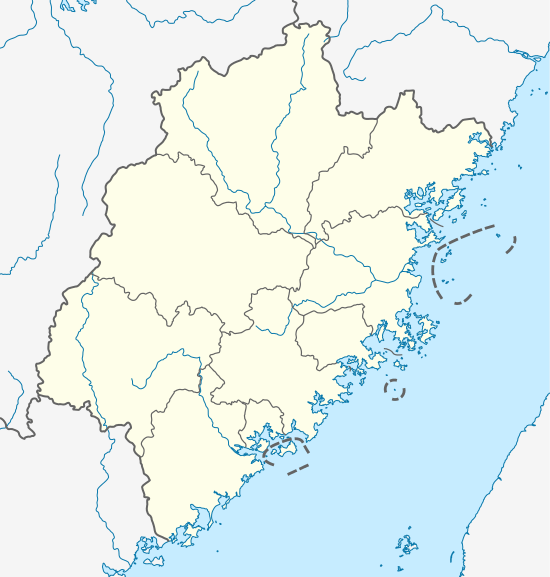Pucheng County, Fujian
| Pucheng County 浦城县 | |
|---|---|
| County | |
 Location of Pucheng County within Nanping City | |
 Pucheng Location in Fujian | |
| Coordinates: 27°54′N 118°31′E / 27.900°N 118.517°ECoordinates: 27°54′N 118°31′E / 27.900°N 118.517°E | |
| Country | People's Republic of China |
| Province | Fujian |
| Prefecture-level city | Nanping |
| Government | |
| • CPC County Committee Secretary | Zhou Yonghe |
| Area | |
| • Total | 3,383 km2 (1,306 sq mi) |
| • Water | 100 km2 (40 sq mi) |
| Population | |
| • Total | 320,000 |
| • Density | 95/km2 (240/sq mi) |
| in the year 2000 | |
| Time zone | China Standard (UTC+8) |
| Website | www.pc.gov.cn |
Pucheng County (simplified Chinese: 浦城县; traditional Chinese: 浦城縣; pinyin: Pǔchéng Xiàn) is a county under the jurisdiction of the municipality of Nanping, in extreme northern Fujian province, People's Republic of China, bordering Jiangxi to the northwest and Zhejiang to the east.
The county is named for the Nanpu Brook, a major tributary to the Min River.
Geography
Pucheng comprises 3,383.02 square kilometres (1,306.19 sq mi) in the Wuyi Mountains which separates Fujian and Jiangxi provinces. It borders Songxi County to the southeast, Jianyang District to the south and Wuyishan City (location of the famous UNESCO park) to the west, all within Nanping. The municipality of Shangrao, Jiangxi, borders to the northwest; those of Quzhou, to the north, and Lishui, to the east, are in Zhejiang.
Culture
Language
Pucheng dialect shares some features with Wu, but is classed among the Southern Chinese varieties. It is however not demonstrably a member of the Min dialect group (which covers almost all of Fujian), and pending further research must stand as an isolate - the sole exemplar of the Pucheng group of Southern Chinese.[1] Some Wu dialects and the Northern Min dialect of Shibei are also spoken in Pucheng.
Intangible Cultural Heritage
- Pucheng-style Papercutting (浦城剪纸)
- Min-school Guqin (闽派古琴)
Administrative divisions
The county administers 2 street offices, 9 towns and 8 townships. The county executive, legislature and judiciary are in Nanpu Street Office, together with the CPC and PSB branches.[2]
Street offices (街道, jiedao)
- Nanpu (南浦) - the county seat
- Hebin (河滨)
Towns (镇, zhen)
- Fuling (富岭)
- Shibei (石陂)
- Linjiang (临江)
- Xianyang (仙阳)
- Shuibeijie (水北街)
- Yongxing (永兴)
- Zhongxin (忠信)
- Liantang (莲塘)
- Jiumu (九牧)
Townships (乡, xiang)
- Wan'an(万安)
- Gulou(古楼)
- Shanxia(山下)
- Fengxi(枫溪)
- Haocun(濠村)
- Guancuo(管厝)
- Panting(盘亭)
- Guanlu(官路)
Transportation
Expressway
- S0311 Pucheng-Jianning Expressway
Specialty
- Pucheng Rouyan/Taipingyan (浦城肉燕/太平燕)
- tofu ball (豆腐丸)
- osmanthus tea (桂花茶)
- wild jujube cake (酸枣糕)
- baojiu (包酒/七倒金)
Archaeology
In 2006 mound tombs of the Wuyue Kingdom were discovered in Guanjiu village. (The kingdom was contemporary with the Spring and Autumn period and Warring States period of the Yellow River-centred Hans). Considered a strongly significant element of Wuyue culture, these are the first such tombs discovered in Fujian Province. 72 bronze funerary articles were excavated from the tombs, making the excavation the largest harvest of bronze items in Fujian archaeological history.
References
- ↑ Norman, Jerry, Chinese, Cambridge University Press, 1988, ISBN 0-521-29653-6. p.243
- ↑ Fujian Sheng Dituce, China Map Publishing, 1999, ISBN 7-5031-2176-9. p.43